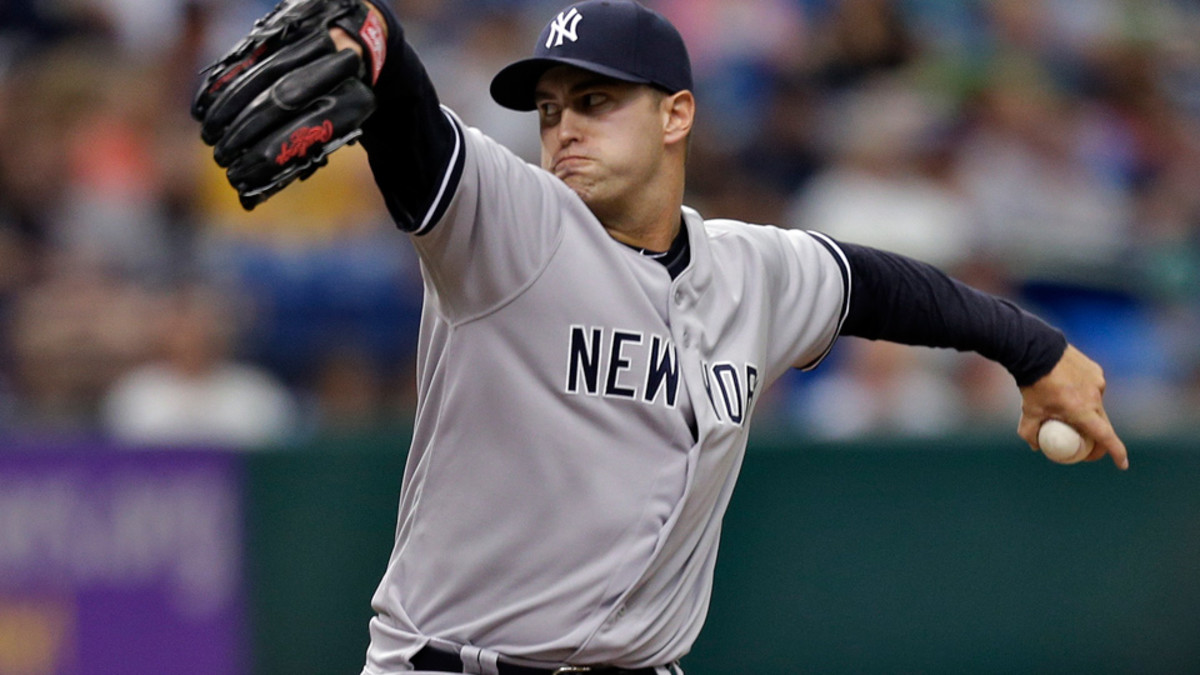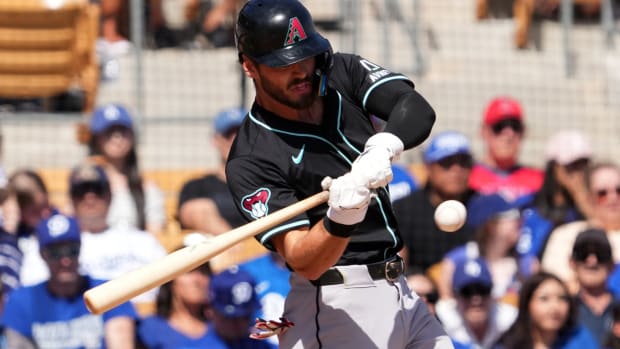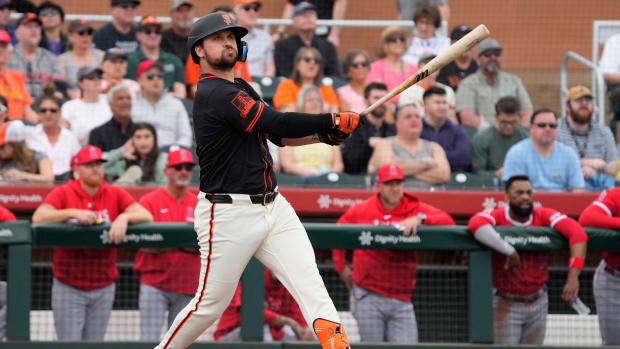Big-spending Yankees winning on the cheap with homegrown pitchers
With their just-completed three-game sweep of the American League East-leading Blue Jays, the Yankees have now won seven of their last nine games and pulled into a three-way tie for the lead in the AL wild-card race. That may not be exactly what the front office had in mind when it committed nearly half a billion dollars to free agents over the winter, but given that New York missed the playoffs last year for just the second time in the last 19 seasons, it seems encouraging.
It's less so when you dig deeper to see that the team's winning percentage is identical to last year's .525 and that its run differential is worse (on a per-game basis). For all of the money the club spent this winter, its success to this point in the season has, with the very significant exception of Japanese import Masahiro Tanaka, come largely on the strength of young, team-controlled players, many of whom may be playing over their heads.
The Yankees are paying eight players $10 million or more this season (not counting Alex Rodriguez, whose $25 million salary was largely erased by his suspension). Here's a quick look at those eight players and their salaries along with the top eight players on the team in Baseball-Reference.com's version of WAR through Thursday's game.
Rank | Player | Salary | Player | bWAR |
1 | $23M | Tanaka | 3.9 | |
2 | $22.5M | 2.2 | ||
3 | Masahiro Tanaka | $22M | 1.6 | |
4 | $21.1M | 1.6 | ||
5 | $17M | Chase Whitley | 1.2 | |
6 | Hiroki Kuroda | $16M | 1.1 | |
7 | $15M | Ellsbury | 1.0 | |
8 | $12M | 0.9 |
Only Tanaka and Jacoby Ellsbury make both lists, and only Tanaka is truly earning his keep out of those two. The 25-year-old Tanaka is also five years younger than the next youngest man on the left side of that list. Carlos Beltran, Jacoby Ellsbury and Brian McCann, the three big bats added to the Yankee lineup this offseason, are hitting a combined .245/.307/.387 on the season. For context, the average American Leaguer has hit .254/.320/.394. Jeter, who will turn 40 on Thursday, is hitting .276/.328/.328 (84 OPS+). Sabathia went on the disabled list with a degenerative knee injury in early May sporting a 5.28 ERA and isn't expected back until August.
On the other side of that table, Pineda is also out until August with a strain behind his right shoulder, and the 30-year-old Gardner is actually older than both McCann and Ellsbury and was signed to a four-year, $52 million extension in April. However, the four players after Gardner are not only all earning less than $600,000 this season, but if DellinBetances hadn't been out of options this spring, all four could have just as easily spent the year at Triple A as been major league contributors.
Instead, Betances has arguably been the best relief pitcher in baseball this year. He leads all pitchers who have thrown at least 40 innings in ERA+ (268), all pitchers with 30 or more innings pitched in Fielding Independent Pitching (0.90) and strikeouts per nine innings (15.1), and all pitchers with 20 or more innings pitched by having struck out 45.5 percent of the batters he has faced. He's also third in the majors in innings thrown among pitchers who have worked purely in relief. Betances has averaged 1.39 innings per appearance, recording four or more outs in 19 of his 30 appearances and pitching two full innings eight times. Meanwhile, he hasn't allowed a run or any of his eight inherited runners to score in any of his appearances of an inning or less.
He's not the only Yankee doing yeoman's work out of the bullpen. Warren is fourth on that list of innings pitched exclusively in relief. Purely a starter in the minors, Warren has made three major league spot starts in his career and has averaged 1.24 innings per appearance out of the bullpen this year. He has recorded four or more outs in a game 14 times in 32 appearances, stranding nine of 12 runners and allowing just two of his own runs in those games.
Closer David Robertson, meanwhile, has struck out at 43.6 percent of the batters he's faced, third-best in the majors. Robertson, Betances and Warren give New York arguably the best end-game in baseball, something few expected in the wake of Mariano Rivera's retirement.
That ability to protect close leads is one explanation for the disparity between the Yankees' won-loss record and their run differential. Teams outplay their run differential by winning close and losing big. That has very much been the Yanks' style this year. They are 8-12 in games decided by five or more runs, but 9-6 in one-run games and 3-1 in extra-innings games that don't overlap either of these other two categories. In those games alone, which account for 55 percent of their schedule, New York has a run differential of -23 but a record of 20-19. In its other games, it is 18-14 with a +4 differential.
Of course, the key to winning close is having a lead in the first place. That's simple enough when Tanaka is on the mound: The Yankees are 12-2 in his starts, with Tanaka going 11-1 in those games. However, Sabathia, Pineda and Ivan Nova (out for the season after Tommy John surgery) are on the disabled list, the 39-year-old Hiroki Kuroda has failed to string together more than two quality starts at any point on the season and rookie Vidal Nuño has posted a 5.24 ERA in 11 starts. That means the only other New York starter with a winning record is Chase Whitley, who is 3-0.
Whitley, who has a 2.65 ERA and 6.5 strikeout-to-walk ratio after his first seven major league starts, has legitimately been the Yankees' second-best starter this season. How unlikely is that? Prior to this year, Whitley was not one of the team's 29 pitchers who were profiled in this year's Baseball Prospectus annual, and he had made just eight starts in his entire professional career, which consisted of four minor league seasons.
Whitley's success stems from his ability to limit walks and home runs and from the changeup and slider that comprise more than half of the pitches he has thrown in the major leagues. As a converted reliever, Whitley lacks endurance. He threw a career-high 95 pitches to beat the Blue Jays on Wednesday, and he has pitched into the sixth inning just twice in his six starts. However, per the above, New York's bullpen is equipped to take the reigns early, and has helped Whitley become just the second Yankees starter ever to avoid a loss through his first seven major league starts (Tanaka was the first).
The team is hoping that David Phelps, another home-grown, pre-arbitration pitcher and one more accustomed to a starter's workload, can replicate Whitley's success. Phelps was a competent swing-man for the team over the last two years, but Sabathia's injury has thrust him into a more prominent role, in which he has had middling results (3-4, 4.19 ERA). In his last two starts, however, the 27-year-old Phelps allowed a total of just two runs in 13 2/3 innings, racking up wins against the division-leading A's and Blue Jays.
This is not, however, a meaningful youth movement. The youngest player among Betances, Gardner, Phelps, Robertson, Whitley and third-baseman Yangervis Solarte is Whitley, who just turned 25 last Saturday, and only Betances was a prospect of any note.
Betances' long-term potential in the bullpen is extremely compelling. Comparisons to another failed starter who emerged as a dominant multi-inning set-up man at the age of 26 are tempting, and not wholly inappropriate, even if comparing anyone to Rivera is inherently unfair. Solarte, however, has hit just .194/.265/.291 since May 15 and is 0-for-his-last-22. Such severe correction is not necessarily in store for the others, but Phelps, Warren and Whitley seem unlikely to be much more than league-average pitchers over the long term.
Where does that leave the Yankees, barring a cavalry ride from Sabathia and Pineda and a big second-half surge from the veterans in the lineup? On the outside looking in come October, a position the franchise may have to get used to.



































